Re-Piercing Ears: Things You Must Know
The art of re-piercing ears comes with possibilities that inspire confidence in you!

Image: Shutterstock
The idea of re-piercing ears can be daunting, especially if you are concerned about scarring. While it is natural to be concerned about complications, with the right guidance, re-piercing can be a safe and rewarding experience. So, if you are contemplating re-piercing your ears, you are in the right place. This article takes you through the different aspects of re-piercing your ears that you need to be aware of, including pain level, healing process, aftercare tips, and the jewelry you should use. Therefore, before taking the plunge, read this article to navigate the process with expertise and care. Scroll down!
In This Article
How To Re-Pierce Ears
Re-piercing ears must be done safely with proper preparation and care. A step-by-step guide based on whether the piercing is fully or partially closed is as follows:
If The Piercing Is Fully Closed

- Consult A Professional: Seek guidance from a professional piercer who can assess the condition of your ears and advise you on the best approach for re-piercing. They may recommend waiting for a certain period to allow the tissue to fully heal and regenerate.
- Prepare The Earlobes: Before attempting to re-pierce, gently massage the earlobes with a mild oil such as jojoba or vitamin E oil. Research shows that jojoba oil possesses emollient and anti-inflammatory properties and may help soften the skin, while vitamin E oil reveals antioxidant properties that promote faster wound healing (1), (2).
- Sterilize Equipment: Ensure that all piercing equipment, including needles, jewelry, and tools, is properly sterilized to minimize the risk of infection. Your piercer should use single-use, sterile needles and follow strict hygiene protocols.
- Choose New Jewelry: Select hypoallergenic jewelry made of materials such as surgical-grade stainless steel, titanium, or 14-karat gold (3). Avoid using nickel-based jewelry as it can cause allergic reactions in some individuals (4).
- Start The Procedure: The piercer will use a sterile needle to create new piercings in the earlobes. They will likely use a piercing clamp to stabilize the earlobe during the procedure, ensuring accuracy and minimizing discomfort.
- Insert Jewelry: The piercer will carefully insert the selected jewelry into the freshly pierced holes to ensure that the jewelry fits snugly but comfortably.
- Follow Aftercare Instructions: If you are wondering how to clean an ear piercing, there is a detailed guide to it. First and foremost, it is a good idea to diligently adhere to the aftercare instructions provided by your piercer. Eve Phillips, a professional tattoo and piercing artist, opines, “Even stretching an old piercing open again causes enough trauma, so full piercing aftercare should again be followed until healed.” The aftercare steps usually involve cleaning the pierced area with saline solution or an antiseptic cleanser twice a day, avoiding touching the piercings with dirty hands, and refraining from swimming or submerging the ears in water until they are fully healed.
- Monitor Healing: Keep an eye on the pierced ears for any signs of infection or complications. If you experience excessive redness, swelling, pain, or discharge, contact your piercer or a healthcare professional promptly (5).
If The Piercing Is Partially Closed
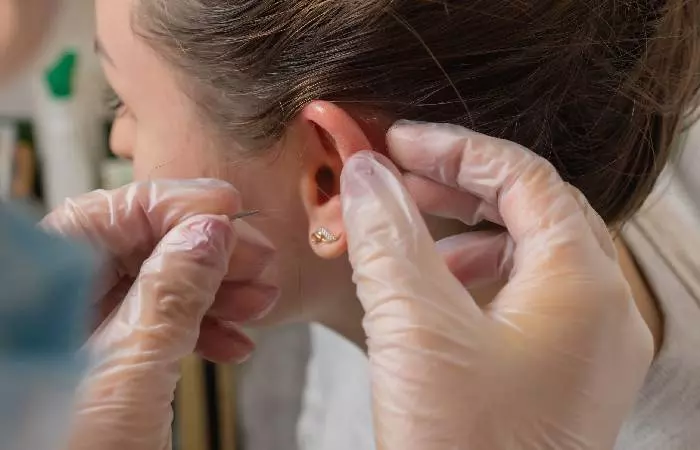
A partially closed piercing means a thin layer of skin has grown over the hole, leaving a tunnel underneath. Avoid forcefully breaking through the skin to prevent infection or bleeding. Try the following steps to reopen a partially closed piercing.
- Take a bath or shower to soften the skin.
- Apply a non-antibiotic ointment such as Aquaphor or Vaseline to keep the skin pliable.
- Gently stretch the earlobe to thin the piercing hole.
- Carefully insert the earring through the back side of the earlobe, using gentle pressure.
- Keep the area clean and wear earrings for a few weeks to prevent closure.
- If you are unable to reopen the piercing with gentle pressure, seek professional assistance to avoid pain or damage.
However, avoid re-piercing your ears at home and visit a professional studio. Here is a guide to what to keep in mind for overall safety purposes.
- Prepare The Earlobes: Follow the same steps as outlined above for preparing the earlobes before re-piercing. Gently massaging the area with oil can help soften the skin and improve circulation.
- Sterilize Equipment: Ensure that all piercing equipment is properly sterilized to minimize the risk of infection. Your piercer should use sterile needles and follow strict hygiene protocols.
- Start The Procedure: The piercer may need to reopen the partially closed piercings using a sterile needle based on the extent of the closure. They will then proceed with the re-piercing process as outlined above.
- Follow Aftercare Instructions: Adhere to the aftercare instructions provided by your piercer to promote healing and prevent complications.
- Monitor Healing: Keep a close watch on the healing process and contact your piercer or a healthcare professional if you notice any concerning symptoms or complications.
Christina, a piercer-cum-blogger, spoke from her experience of piercing ears what one should do when their piercing is closed: “The first thing that you want to do is see if your piercing is actually closed. I would say more than half of the time I would get an earring through their ear. So usually the trick is, of course, to try to go through the front. If I had trouble, I would then go through the back of the hole, and sometimes, going through the back of the hole, it would be easier to find the angle because, sometimes, piercers do pierce on an angle, they don’t pierce exactly straight through (i).” She added, “Another thing that I would recommend is trying a piercing earring. Piercing earrings are a little bit sharper and that’s just to get through that extra layer of skin that you just need to poke through, it just makes it easier to guide it through….I always use my thumb as a guide when I’m putting my earring through. I put my thumb right on the back of the hole, you can usually feel it, and then I just poke the earring in.”
Seeking guidance from a professional piercer and following the above steps can help you safely re-pierce your ears. Keep scrolling to learn more about re-piercing ears and what it entails!
Key Takeaways
- Re-pierced ears usually take 6-12 weeks to heal completely based on factors such as an individual’s healing ability and aftercare.
- One can use numbing creams or ice packs to minimize discomfort during the re-piercing procedure.
- Allowing ample time for healing before changing or removing earrings and re-piercing can help prevent complications.
- It is crucial to seek the expertise of a professional piercer and discuss any concerns and relevant medical history with him or her before re-piercing.
- Proper aftercare is essential for preventing infections associated with re-piercing ears.
Can Ears Be Re-Pierced In The Same Spot?
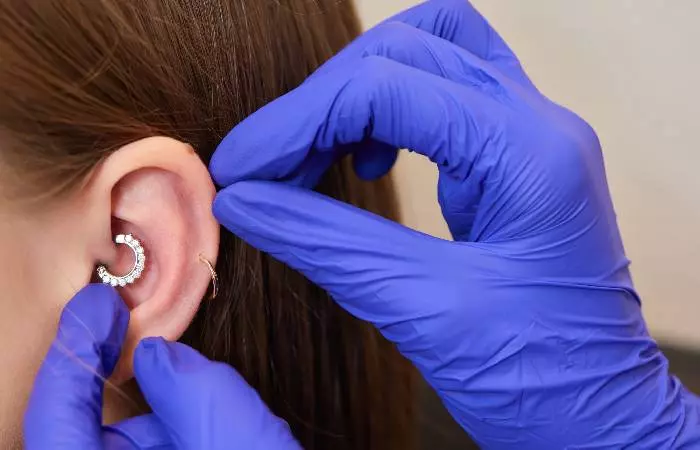
Re-piercing ears in the same spot can be a delicate process, demanding careful attention. Before proceeding, assess the condition of the previous piercing site, considering factors such as scarring, tissue health, and any underlying issues. We highly recommend consulting a professional piercer as they can determine the feasibility of re-piercing and offer personalized advice.
If the previous piercing is fully closed, the piercer will need to use a sterile needle to create a new opening, taking care to align it correctly with the previous site. For partially closed piercings, the piercer may need to gently reopen the hole before proceeding with the re-piercing process.
Proper sterilization of equipment, selection of hypoallergenic jewelry, and adherence to aftercare instructions are essential to minimize the risk of complications and promote healing. Re-piercing the ears can result in beautifully adorned earlobes if you practice patience and caution.
It is reassuring to know that re-piercing is a completely safe procedure if done right. But are there certain locations more suitable for it than others? Let us find out in the next section.
Where To Get Ears Re-Pierced
Some common locations for ear re-piercings include the following.
- Earlobe: The earlobe is the most common location for ear piercings, suitable for both initial piercings and re-piercing.
- Helix: Helix piercings can be placed anywhere along the outer edge of the ear, and they are a popular choice for those looking for a more unique or edgy piercing style. If you’re re-piercing your helix, you may choose to pierce the same spot or select a new location for a fresh look.
- Tragus: The tragus is the small, thick piece of cartilage that partially covers the ear canal. Tragus piercings are trendy and can add a subtle yet stylish accent to your ear.
- Conch: The conch is the central part of the ear, located adjacent to the ear canal. Conch piercings can be done on the inner or outer conch, offering versatility in style.
- Daith: The daith is the small area of cartilage located above the ear canal, closer to the inner ear. Daith piercings have gained popularity for their unique appearance and potential for migraine relief.
- Rook: The rook is the fold of cartilage located in the upper part of the inner ear, between the helix and the inner conch. Rook piercings can be visually striking and offer a distinct look.
When deciding where to get your ears re-pierced, consider your personal style preferences, anatomy, and any previous piercings you may have had in that area. Each spot offers its unique style, so consider your preferences and consult with a professional piercer for guidance on placement.
Nevertheless, re-piercing can also cause some level of pain. Check out the following section to learn about the usual pain level associated with this type of procedure.
Pain Level Of Re-Piercing Ears

The pain level experienced during ear re-piercing varies based on individual pain tolerance and individual circumstances. Different psychological factors, like stress and anxiety, can also worsen individual pain intensity. Generally, re-piercing in the same spot may cause discomfort similar to or slightly more intense than the initial piercing. You may imagine it as a pinch or a quick snap such as the sting of a bee. It is a sensation that is intense but brief.
 Did You Know?
Did You Know?Factors such as the thickness of the earlobe, the skill of the piercer, and the presence of scar tissue can also influence the level of pain. However, the pain is usually tolerable and short-lived, lasting only a few seconds during the actual piercing process. Proper preparation, including the use of numbing agents if necessary, can help mitigate discomfort. With the right mindset and perhaps a dash of courage, you can achieve beautifully re-pierced ears and flaunt them with pride.
No matter the pain level, is there a period of time one should wait before re-piercing their ears? The next section reveals the answer to that.
How Long After Healing Can I Re-Pierce My Ears?
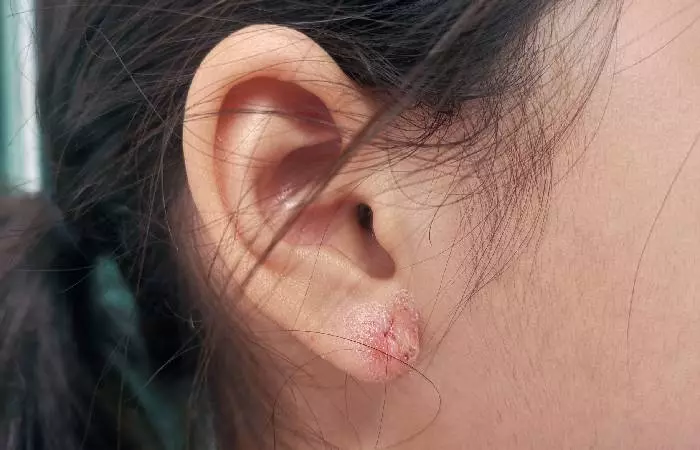
When it comes to re-piercing your ears after undergoing an earlobe repair, it is best to wait till the area heals completely. You should wait until your earlobes have fully healed before re-piercing them, usually about 6 to 12 weeks, depending on the extent of the repair, your healing progress, and your surgeon’s recommendations. Rushing the re-piercing process can increase the risk of complications and slow down healing. Re-piercing requires a blend of precision and patience.
 Trivia
TriviaSometimes, wounds leave behind scar tissue when they heal. Can you re-pierce your ears if that happens? Let us find out in the next section.
Re-Piercing Ears Through Scar Tissue

Scars are a common outcome of healing wounds or injuries. The scar tissue from previous piercings may make re-piercing more challenging and possibly affect the healing process. It is essential that you prioritize both physical and psychological health throughout the scar repair process (6). Approach re-piercing through scar tissue cautiously to minimize risks and promote successful healing. We recommend consulting a professional piercer experienced in dealing with scar tissue to determine the best approach for re-piercing.
In some cases, the piercer may need to rely on specialized techniques such as using a sterile intravenous cannula (a thin tube) to create a precise hole, which helps reduce the risk of infection, especially when piercing through cartilage (7). The piercer may recommend choosing a different spot for piercing if there is a lot of scar tissue to avoid complications. Individuals prone to keloids should be cautious with re-piercing as there is a risk of developing them again with it. Research shows that an individual with a family history of keloids may have to refrain from getting their ears pierced (8). If there is significant scar tissue, it is best to avoid another piercing on the same location to prevent further complications.
Wearing simple jewelry can make your piercings look more prominent and elevate your appearance. Continue reading to explore the jewelry options for re-pierced ears!
Can I Use The Same Jewelry For Re-Piercing?

Using the same jewelry for re-piercing is not recommended due to the risk of potential complications. Avoid reusing old jewelry as it may harbor bacteria or contaminants. Even if the jewelry appears clean, it may harbor unseen pathogens that could lead to infections or other issues during the healing process. Opting for new, sterile jewelry for re-piercing can help minimize these risks and promote a smoother healing journey. Consulting a professional piercer is essential to ensure the selection of appropriate jewelry that suits your needs and supports optimal healing.
We recommend opting for simple studs or hoops instead of elaborate or dangling earrings during the re-piercing process to minimize movement and reduce the risk of irritation. Choosing jewelry of appropriate size and gauge for the earlobes help ensure a comfortable fit and prevent excessive pressure or stretching on the newly pierced area. When selecting jewelry for re-piercing ears, it is essential to prioritize materials that are hypoallergenic and less likely to cause irritation (3).
The journey to redefine your ear adornments is as much about self-expression as it is about safety and care. With the right knowledge and guidance, re-piercing the ears offers an opportunity for a fresh start and a renewed sense of confidence. From visiting a professional piercer to selecting the best jewelry, followed by proper aftercare, each step plays a crucial role in ensuring a safe and successful experience. So, whether you are seeking to refresh your style or rediscover your identity, remember to approach re-piercing with patience and a dash of courage.
Frequently Asked Questions
What is the best method for sterilizing earrings and equipment before re-piercing?
The best method for sterilizing earrings and equipment before re-piercing is through autoclaving, a process that uses high-pressure steam to kill bacteria. This method is highly effective in making sure that all instruments, including needles and jewelry, are safe for use during the re-piercing procedure.
Should I numb my ears before re-piercing to minimize pain?
Using a numbing cream before re-piercing can help minimize pain, but it is essential to consult a professional piercer or healthcare provider before using any numbing products to ensure they are safe and appropriate for your situation. While numbing creams can reduce discomfort, they may not eliminate it entirely.
Can I re-pierce my ears at home, or should I go to a professional piercer?
We highly recommend going to a professional piercer for re-piercing your ears, as they have the expertise, sterile equipment, and knowledge to ensure a safe and successful procedure. Attempting to re-pierce at home can increase the risk of complications such as infection, improper placement, or excessive pain.
How do I care for my ears after re-piercing to prevent infections?
After re-piercing, clean your ears twice daily with saline solution or an antiseptic cleanser. Avoid touching your piercings with dirty hands and refrain from swimming until they are fully healed. Remember to adhere to the aftercare instructions provided by your piercer to minimize the risk of infections.
Ear re-piercings are not always painful. Get ready to elevate your look and embrace re-piercings by watching this short YouTube video of a re-piercing session conducted by an expert!
Personal Experience: Source
StyleCraze's articles are interwoven with authentic personal narratives that provide depth and resonance to our content. Below are the sources of the personal accounts referenced in this article.
(i) HELP! I Think My Piercing Holes are Closed?https://www.youtube.com/watch?v=F1sn9OCmPFU
References
Articles on StyleCraze are backed by verified information from peer-reviewed and academic research papers, reputed organizations, research institutions, and medical associations to ensure accuracy and relevance. Read our editorial policy to learn more.
- Jojoba oil: An updated comprehensive review on chemistry pharmaceutical uses , and toxicity
https://www.ncbi.nlm.nih.gov/pmc/articles/PMC8197201/ - Vitamin E in dermatology
https://www.ncbi.nlm.nih.gov/pmc/articles/PMC4976416/ - Jewelry for initial piercings
https://safepiercing.org/jewelry-for-initial-piercings/ - Immunological mechanisms of metal allergies and the nickel-specific tcr-pmhc interface
https://www.ncbi.nlm.nih.gov/pmc/articles/PMC8535423/ - Complications and hazards associated with body piercing: A narrative review
https://pubmed.ncbi.nlm.nih.gov/37916624/ - Research progress of scar repair and its influence on physical and mental health
https://www.ncbi.nlm.nih.gov/pmc/articles/PMC8784744/ - Ear piercing—a simple solution
https://www.researchgate.net/publication/350668808 - Relationship between age of ear piercing and keloid formation
https://pubmed.ncbi.nlm.nih.gov/15867040/
Read full bio of Eve Phillips
Read full bio of Vaishali Sinha
Read full bio of Subhrojyoti Mukherjee
Read full bio of Gracia Odile










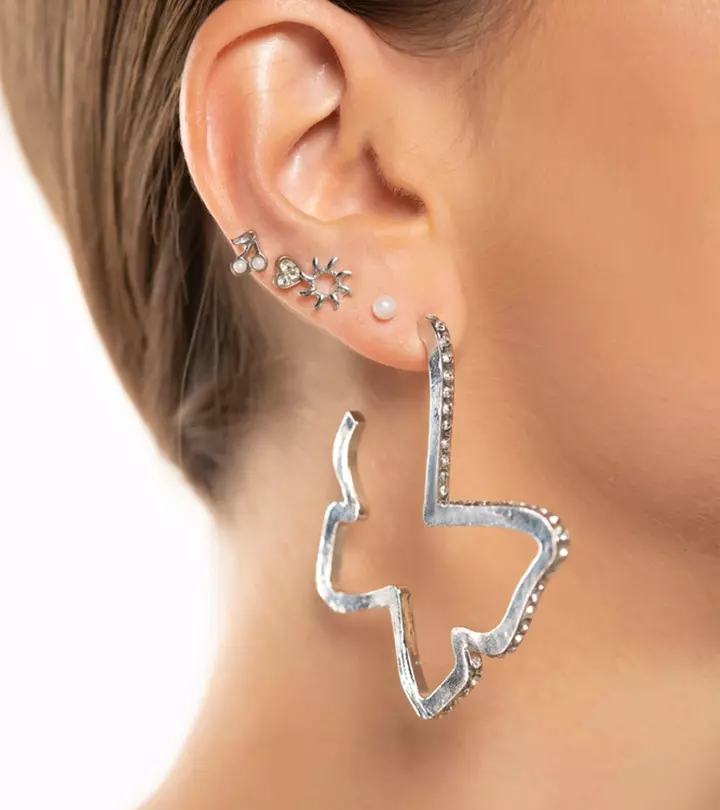









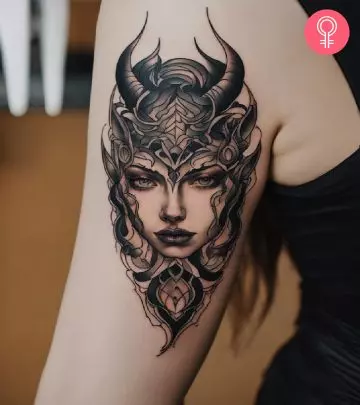



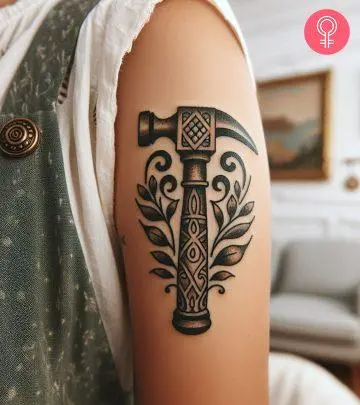


Community Experiences
Join the conversation and become a part of our empowering community! Share your stories, experiences, and insights to connect with other beauty, lifestyle, and health enthusiasts.